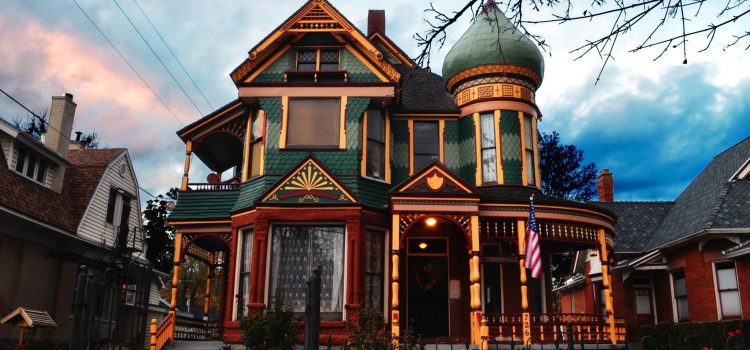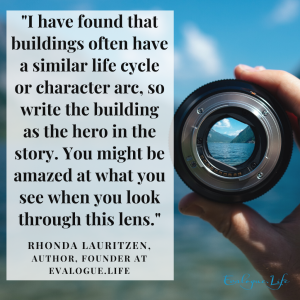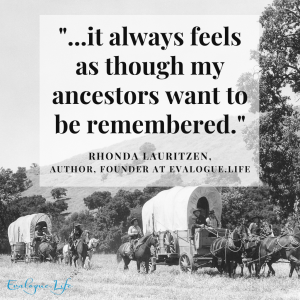
There can be an uncanny connection to ancestral homes and the places where our forebears walked. In our line of work, we’ve noticed some pretty interesting phenomena where people are drawn to places their ancestors lived or had unusual coincidences. In addition, it’s just pure fun to research the history of a building or place. In this article, I will share a quick list of how I approach this type of project. At the end, I’ll share links and examples to some of the fun stories I’ve had the privilege of telling. It is my hope that perhaps these stories surrounding ancestral homes might inspire you in some way.
As a side note, I got into this work by accident while my husband and I restored the very special Andrew J. Warner House shown in the header photo above.
Here are my steps for researching ancestral homes and buildings:
Before you begin the research, you’ll want to get organized and have a good method for digitizing what you find. To get you started, here are some articles and tutorials to help you digitize and organize big projects. Trust me that you’ll want to invest in the organization upfront or it will eat your lunch later. These steps below are not necessarily in order, and I try to do as many simultaneously as possible.
Before continuing, here are a few related articles that might help you:
- Article: Tips to digitize slides, photos and other family history
- How I digitize large quantities of photos and documents fast
- Video tutorial: organizing a big writing project
Step 1: Ask current owners or anyone with knowledge about the ancestral home
Find out everything you can from the current owners or residents about your building. Here are some good questions to start with.
- Do they know the names of anyone who ever lived in the building or owned it?
- Were any businesses attached to the property?
- Who were the owners of those businesses?
- Do the current owners have any photos, newspaper articles, scrapbooks, etc.?
- Do they know anyone living who worked or lived in that building?
Ask around to find out who the community experts are on the property or subject and be sure to give these people a call. Treat these people like gold and be respectful of their work, copyrights, etc. Always ask permission before using or sharing what they give. Give proper credit in your work for their help. And, of course, write down all names, dates, and leads.
Step 2: Do a title search on the building
I learned the hard way that it is invaluable upfront to do a title search for the whole history of the property. If you don’t have the knowledge or access to do it yourself, this is something to pay someone local to do. Title company agents are the most likely people to hire because they’ll have a subscription with the County recorder’s office. You’ll want to get copies of all the deeds you can because the names on the deeds can turn up a wealth of information.
Step 3: Research city directories of the home
Do a search of city directories to learn everyone who lived in the ancestral home or who had a business there. Public libraries generally keep these, but it’s amazing to have them all digitized now through MyHeritage. Keep an eye out for any ads associated with the property.
Step 4: Pull fire insurance maps and birds-eye view maps
If the property is located somewhere that there were birds-eye view maps, these can provide wonderful information. Pull these from the Library of Congress. If you find one, then zoom in to the block. Also, pull any fire insurance maps over time and zoom in to the block to see any structures and changes over time.
Step 5: Do a search of newspaper articles and a general internet search of the ancestral building
Do a search on Newspapers.com or with any local newspapers related to the address, as well as any business names and former owners/residents. This can return wonderful details! If the property is located in a small town, the newspapers may not be digitized. If this is the case, the local library, university, or museum may have them on microfilm. Ask around to find out where these are located. If they are only on microfilm, however, they may not be indexed. Searching through these can be like looking for a needle in a haystack unless the ancestral building was a business that advertised regularly. It goes without saying that you’ll search the web.
Related article: How to inspire with your canon of business stories
Step 6: Go onsite to special collections, museums etc.
There are some things you’ll never find unless you go to local archives which may be housed at a public library, university, museum, or with local heritage societies. Don’t make the mistake of thinking everything is digitized.
Step 7: Do family history research
Next, based on the names that come up and how much time you’re willing to spend, you can do family history research. At the very least, I always look up any prominent residents on FamilySearch to see if you can find any stories.
One piece of advice is that if you are doing research on any town or building where there are Mormon Pioneer roots, be sure to check out the Church History Library. There can be a treasure trove of resources that may not be available anywhere else, like journals, town histories, letters, and more. This is different than the famous Family History Library.
Related article: Finding forgotten voices in the Church History Library
Step 8: Post a call for history on social media
I always like to post a call for history in local history Facebook groups regarding any building I’m working on. You’ll usually get a ton of people giving memories, local stories, and photos. I’ve been amazed at what has dropped in my lap while researching ancestral homes. It’s been uncanny!
Related article: There are no coincidences – prayer and the uncanny
Step 9: Consider oral history
If there are people still living with memories of the property or who may be keepers of related family history, consider interviewing them. Remember the questions from step 1 above.
Related article: Power of place
Step 10: Do secondary research
Once you have done sufficient primary research, be sure to consult any local history books that might discuss the place, time period, etc. With a background of your own research firmly in place, you’ll be able to spot any inaccuracies. Secondary research can help you understand the context and research that has already been done, and to check your assumptions. Be sure to properly cite what you find. This is where your initial organizational work will really come in handy. (If you haven’t already, watch this tutorial on organizing big projects to see what I mean.)
Finally, it’s helpful to understand local history so you can write about the time and place in context. Look for books about community history for this sort of thing.
Related: Take our short course on how to conduct oral history interviews.
Then, write the story or make a video and share
Once you complete the research on your ancestral home, you have to decide the format for sharing. Will it be an article? A coffee table book? A National Register nomination? A video? Below are two resources for making videos, and below those are some examples of stories about buildings and places I have done. One piece of advice is to remember that it is a story. I have found that buildings often have a similar life cycle or character arc, so write the building as the hero in the story. You might be amazed at what you see when you look through this lens.
Related article: Story Structure- strengthen any story with these tips and examples
Three tutorials to help you tell stories of ancestral homes
Here is a video tutorial entitled: How to make easy video stories your family will love.
Ten ideas for how to make video stories using free and easy tools (Adobe Spark and Animoto)
Article: story structure – strengthen any story with these tips and examples

Some examples of videos and stories:
In hopes that you might gain some inspiration, here are some examples of how I have shared the stories of buildings and places with the community.
- The untold history of the Ephraim Relief Society Granary (short video)
- The Ogden Hinckley Airport’s role in WWII (short video)
- History of the Ephraim Relief Society Granary (article)
- When the walls talk, messages from a Queen Anne Victorian (article)
- A house through time – The story of the Andrew J. Warner House (short video)
- History of the Ogden Union Stockyards (full website with oral histories and articles)
- When the places of our ancestors beckon us – a nod to Zion National park history
We have done other projects including national register nominations, a Cultural Landscape report history for Salt Lake City’s Pioneer Park, histories of private homes, and the history of Electric Alley behind Ogden Utah’s notorious 25th Street. It’s always an adventure as we search and make discoveries about ancestral homes and buildings. I believe the stories of these buildings are worth being told. I hope these resources and examples inspire you to get to know the powerful places in your family history. Who knows what new heroes you’ll meet.

Rhonda Lauritzen is the founder and an author at Evalogue.Life – Tell Your Story. Rhonda lives to hear and write about people’s lives. She believes that when you tell your story, it changes the ending., She and her husband Milan restored an 1890 Victorian in Ogden. She especially enjoys unplugging in nature. Check out her books: How to Storyboard, and Every Essential Element. Most recently she was the writing coach of bestselling author, Rob A. Gentile, who wrote Quarks of Light, A Near-Death Experience: What I Saw That Opened My Heart





You may also be interested in this guide from the Library of Congress.
https://guides.loc.gov/house-history
Thanks Sheree! That’s a fabulous resource that wasn’t on my radar.